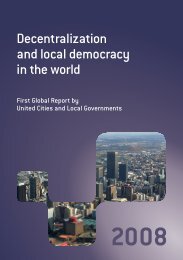Making Cities Resilient Report 2012
Making Cities Resilient Report 2012
Making Cities Resilient Report 2012
Create successful ePaper yourself
Turn your PDF publications into a flip-book with our unique Google optimized e-Paper software.
CHAPTER 4 | What are local governments doing to build resilience<br />
In flood-prone areas, the removal of informal settlements and other unauthorised structures along<br />
waterways is sometimes seen as a proactive measure. Albay Province and Makati City have begun largescale<br />
relocation programmes, in partnership with local NGOs. In Colombo, unauthorised structures on<br />
top of drains and encroachments into canals have been removed. In Kampala, the local government has<br />
sought to evict people encroaching on wetland areas. While in some situations the relocation of informal<br />
settlements along waterways may have the desired impact of preventing flooding, it often has a serious<br />
socio-economic impact on the communities being relocated (see more under Essential 6).<br />
5. Protect Vital Facilities: Education<br />
and Health<br />
Essential 5: Assess the safety of all schools and health facilities and upgrade these as necessary<br />
The safety of schools and hospitals is a top priority for any resilient city. The ‘One Million Safe Schools and<br />
Hospitals Campaign’ sought to reinforce this concept by encouraging individuals, families, communities,<br />
organisations, governments, businesses and other entities to pledge to work for safer schools and hospitals<br />
(www.safe-schools-hospitals.net). This is part of the <strong>Resilient</strong> <strong>Cities</strong> Campaign, and builds on the 2006-2007<br />
Global Campaign on Safe Schools, and the 2008-2009 Global Campaign on Safe Hospitals. Many cities have<br />
committed to these principles and several Campaign cities report activities to enhance the construction<br />
safety of schools and hospitals to support their continued operation in the event of a disaster.<br />
The WHO/PAHO Hospital Safety Index (a low-cost tool to assess the ability of health facilities to remain<br />
functioning in emergency situations) was promoted during the UNISDR One-million Safe Schools and<br />
Hospitals Initiative. In Makati City, the Hospital NG Makati applied the Index and the hospital has been<br />
assessed as ‘generally safe,’ meaning that it will not collapse, can continue to function in a disaster, and<br />
is well-organised with contingency plans and trained health personnel. Using customised ‘safe hospitals’<br />
indicators, Barangay health centres have also been assessed as ‘relatively safe.’ (31). Other cities that have<br />
made progress on safe schools and hospitals include Cape Town, Makassar, and Quito. In Cape Town, all<br />
17 Environmental Health Offices and 18 of 80 clinics have achieved a quality assurance rating from South<br />
Africa’s Council for Health Services Accreditation. All schools undergo mandatory safety inspections by<br />
the Health and Safety Committee (33). Makassar has instituted school and hospital safety assessments,<br />
and the departments of Public Works, Education and Health are working on rehabilitating school and<br />
health facilities (38). In Quito, the Municipality is conducting structural studies of schools and essential<br />
city buildings against seismic hazards. This used to be the responsibility of central government, but was<br />
decentralised in 2011. (35)<br />
6. Urban Planning and Building<br />
Regulations<br />
Essential 6: Apply and enforce realistic, risk compliant building regulations and land use planning<br />
principles. Identify safe land for low-income citizens and develop upgrading of informal settlements,<br />
wherever feasible.<br />
The strategies under this Essential are central to reducing disaster risk, but some of the measures needed<br />
to do so are among the most difficult to implement. It is difficult for any city government to ensure that lowincome<br />
households can buy, build or rent housing located on safe sites. Upgrading informal settlements<br />
has become the norm in many cities and this can be linked to disaster risk reduction. But it still remains<br />
politically controversial in many others. Integrating an in-depth understanding of disaster risk into urban<br />
plans and land-use management requires good inter-sectoral coordination as well as detailed local data<br />
on risks and a commitment to disaster risk reduction.<br />
<strong>Making</strong> <strong>Cities</strong> <strong>Resilient</strong> <strong>Report</strong> <strong>2012</strong> | 53

















